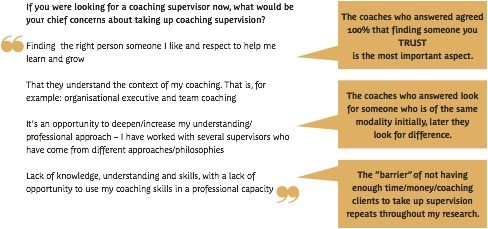Showing value and building trust are key for coaches in supervision. The Association of Coaching Supervisors looks at the supervisor’s ‘client life cycle’
By Peter Welch and Lorenza Clifford
Building on anecdotal evidence shared in supervision groups, encouragement from the Association for Coaching (AC)’s Anne Calleja, and research by Alison Hodge (Hodge, 2014), one of this column’s authors, Lorenza Clifford, constructed two small surveys and led two virtual discussions with international supervision groups.
One group was chaired by the other author of this column, Peter Welch, of the Association of Coaching Supervisors (AOCS), the other by the AC’s Carol Whitaker. These revealed interesting indications about what’s happening for coaches around take-up and use of coaching supervision.
The good news is that our education efforts are working! The assertion that “Most coaches/mentors know that supervision is best practice according to their professional body” was widely agreed with, and 100% agreed with by coaches.
The top three ways that coach supervision was introduced were:
- through CPD (80%)
- during certification training (40%)
- through posts and communications from professional bodies (40%)
Other introductions (all at 20%) came from articles in coaching publications, during accreditation preparation and as client requirements or peer suggestions.
Supervisors and coaches perceived different criteria creating the need to take up supervision:
Where supervisors see ‘market need/client or employer demand’ and ‘accreditation requirement’ as top drivers for entry into supervision, coaches initially prioritise ‘regular and non-specific support’ and ‘dealing with complexity in client work’.
This reinforces supervisors need to contract with coaches for the value they seek and remember this throughout.
Supervisors most frequently pointed at affordability as a perceived barrier in terms of money and time. This was also mentioned by coaches, though some felt they had no barriers to supervision.
Discussing supervision experiences when working with new coaches and fledgling coaching practices, early coaching supervision actually increases profitability, as it helps bolster action when you have too few clients, articulates your approach to potential clients with clarity and increases confidence to be your best when in chemistry sessions.
We asked about supervisees’ concerns at first take-up: Trust and the fear of being exposed/judged was revealed again, along with the fear of being misunderstood (see quotes, below). Early on, supervisees seek similar modality. As they develop, they value the challenge of different modalities, approaches and perspectives.
Initially, coaches overwhelmingly want time to think, safe from judgement. Later, while non-judgemental reflection space is still most important, there’s a vast range of other valuable aspects mentioned.
When looking at value of continuing the existing supervision relationship, benefits are created by deepening trust, through addressing patterns in challenges, feeling known, respected and valued and, through modelling, growing deeper client relationships.
Great value can come from a new supervisor with contrasting experience and modalities. Fresh perspective and new areas of focus could be brought. What happens in the relationship brings relevant learning, when examined dynamically.
We discussed “different flavours of supervisors from different schools”. New affirmations and diverse challenge are highly valuable to bring fresh debate, new inspiration and insights to experienced coaches.
In relation to the maturing market, supervisors may become ever more aware of where they bring best value and develop more distinct niches to appeal to coaches in the future. We will continue to survey the expectations and needs of both parties.
Application
How the authors have used what they discussed with potential supervisees
Lorenza Clifford
- I ask what they hope to gain from supervision and link to that, rather than explaining what I do, which I now leave to the end of the call.
- I ask more about what kind of coaching they do, about the modalities they use in their approach, and demonstrate my understanding of those modalities through my follow-up questions, or sharing an experience to build communality in a very conversational way, rather than listing training and qualifications.
- I describe the co-created safe space and the richness of the conversations: how the gentle challenge from me in the context of their own development goals, impacts the coach’s awareness and relationship with the concepts we discuss. As meaning-making shifts, so their personal approach, relationships and coaching practice moves forward.
- I champion accreditation as a rich learning experience and explain ‘SuperVision’ helps us see through that lens, allowing accreditation to become something to relish, rather than mere box ticking or paperwork. Resulted in two ‘very interested’ coaches for a trio group.
Peter Welch
- Trusting a stranger: I’ve been very consciously providing a ‘warm response’ to new enquiries for supervision from coaches, eg, reassuring them about the ‘fear of exposure’ issue. I have taken on two new supervisees and started a new local supervision group as a result.
- Barriers to entry: I have offered new group of supervisees a reduced fee deal for committing to a year’s supervision.
- Life cycle: I’m actively considering re-contracting with some longer-term supervisees, to ask what they would like to ‘be different’ in our sessions.
Find out more
- if you’d like to know more about forthcoming field research, email: Lorenza.clifford@coachange.org
- Clifford runs trio groups and one-to-one coaching supervision. Read her AOCS profile here: http://bit.ly/2vg6rIC
- Welch supervises coaches individually and in groups, both virtually and face to face. Read his AOCS profile here: http://bit.ly/2OFOXfA
Reference
- A Hodge, An Action Research Inquiry in what goes on in coaching supervision to the end of enhancing the Coaching Profession, Doctoral thesis, Middlesex University, 2014 (Discussion, pp 20-21 and the Mind Map, p 328)

